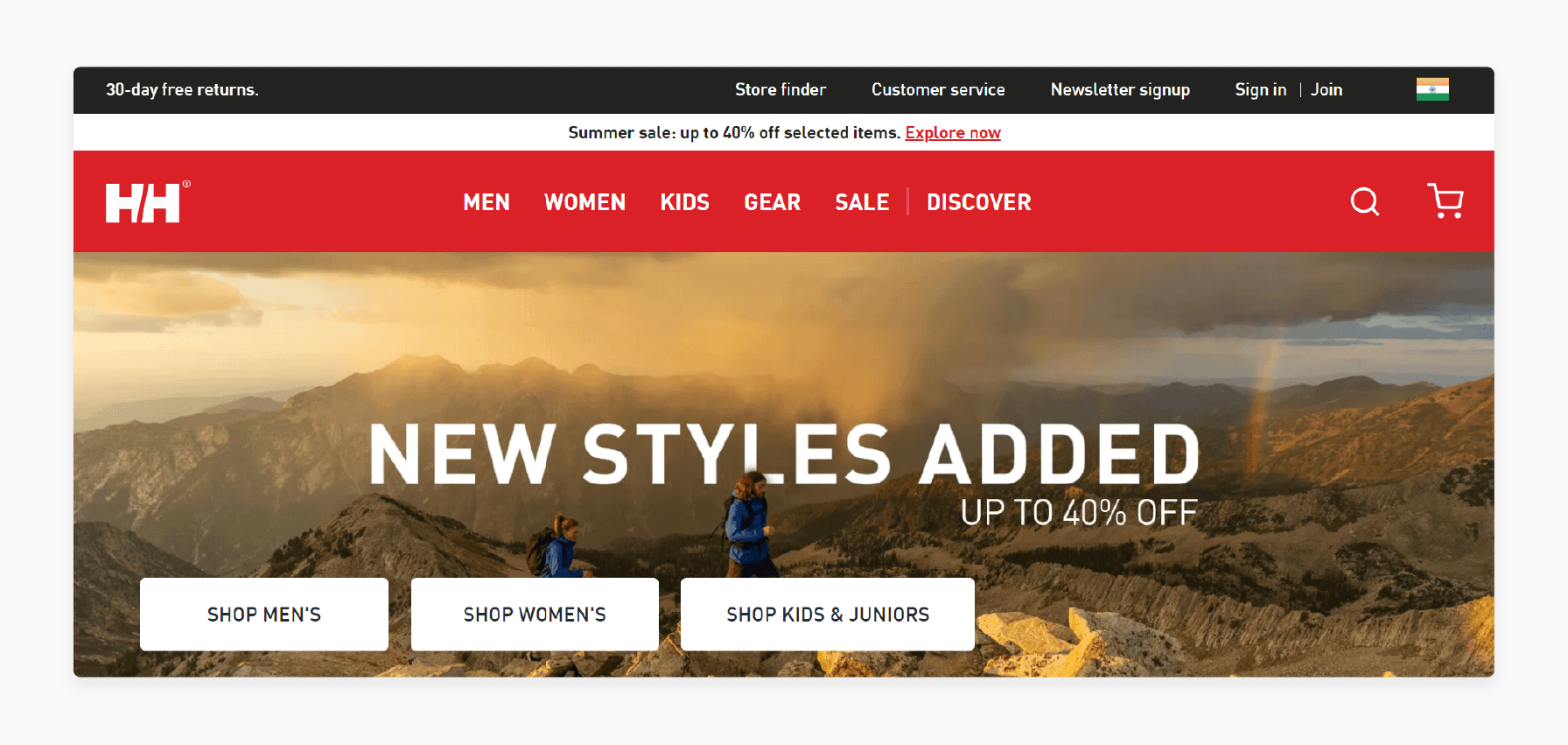
Magento Implementation: Benefits and Pre-Implementation Analysis
Ready to boost your online sales with Magento 2? Magento Implementation involves setting up the Magento platform. It also includes customizing it to meet specific business needs.
This article will cover how to implement Magento 2 effectively. You will learn about strategic planning and essential configurations.
Key Takeaways
-
Discover the key stages of Magento implementation. These stages include discovery, coding, testing, and production launch.
-
Learn how to enhance your Magento store's user experience (UX) and interface (UI). Improved UX and UI lead to better customer engagement.
-
Explore the latest Magento features and integrations.
-
Uncover strategies to boost your Magento store's search engine visibility and product discoverability.
What is Magento Implementation?
Magento, now owned by Adobe, is a top choice for businesses looking to launch or enhance their online store. Magento provides an extensive range of built-in functionalities that support multi-store operations. Magento's multi-store functionality allows businesses to manage multiple websites, stores, or store views from a single backend. This feature is valuable for companies operating in different countries or targeting distinct market segments.
For example:
-
A clothing retailer can manage separate storefronts for men's, women's, and children's clothing from one admin panel.
-
An international business can operate country-specific stores with localized languages, currencies, and product offerings.
It also offers advanced product management and powerful marketing tools. The open-source framework facilitates deep customization to fit distinct business requirements. Magento's integration within the Adobe ecosystem enhances its marketing and analytics capabilities.
Focus Areas:
-
B2C Sector: The emphasis is on crafting an engaging and intuitive user interface. It includes prioritizing features such as product recommendations and easy Magento site navigation.
-
B2B Sector: Implementations here often demand complex pricing models and sophisticated approval workflows.
Benefits of Implementing Magento for Your Ecommerce Store
1. Versatility and Scalability
Magento caters to businesses of various sizes and types:
| Business Type | Magento Solution |
|---|---|
| Small to Medium | Magento Open Source |
| Large Enterprises | Adobe Commerce |
| Cloud-based needs | Adobe Commerce Cloud |
2. User Experience and Design
-
Layered navigation allows customers to filter products based on multiple attributes such as size, color, price range, or brand. Here's how it enhances user experience:
-
Reduces search time: Customers can quickly narrow down options to find exactly what they're looking for.
-
Improves relevance: By applying multiple filters, users see only the most relevant products, increasing the likelihood of a purchase.
-
Enhances discoverability: Users can explore products by different attributes, potentially discovering items they hadn't initially considered.
-
Reduces frustration: By eliminating irrelevant results, customers are less likely to leave the site due to information overload.
-
-
One-page checkout streamlines the purchase process.
-
Personalized product recommendations based on browsing history.
-
Responsive design capabilities, ensuring a consistent experience across devices.
-
The advanced search functionality includes autocomplete and search term suggestions.
These features collectively reduce friction in the shopping process. It can increase conversion rates and enhance customer satisfaction.
3. Integration and Extensibility
-
ERPs (Enterprise Resource Planning): By connecting Magento to an Enterprise Resource Planning system, businesses can
-
Automate inventory updates
-
Order processing
-
Financial reporting
This reduces manual data entry, minimizes errors, and provides real-time visibility into business operations.
-
-
PIMs (Product Information Management): Integration of Product Information Management systems allows for centralized management of product data. This ensures consistency across all sales channels. It simplifies the process of updating product information, especially for businesses with large catalogs.
-
Payment gateways: Magento supports various payment gateways, allowing businesses to offer multiple payment options to customers. This flexibility can increase conversion rates by catering to customer preferences and building trust through recognized payment methods.
-
Third-party services and APIs
4. Community and Support
| Aspect | Benefit |
|---|---|
| Large community | Extensive resources and support |
| Skilled developers | Easy to find experienced professionals |
| Regular updates | Continuous platform improvement |
5. Implementation Approach
Magento allows for a phased implementation:
-
Start with a minimal viable product.
-
Conduct business analysis.
-
Develop user stories and acceptance criteria.
-
Create a fully working prototype.
-
Add more features and extensions over time.
-
Cost Considerations.
Pre-Implementation Analysis for Magento Implementation
1. Business Needs Assessment:
-
The first step is to assess the business model, whether it's B2C, B2B, or a combination of both.
-
Consider the complexity and volume of the product range.
-
Also, take into account the target market's geographic scope and customer segments.
-
Test short-term and long-term growth plans to ensure scalability.
2. Technical Requirements:
-
Analyze the server infrastructure needed to support the Magento store.
-
Identify integration requirements with systems like ERP and PIM.
-
Determine security requirements and set performance expectations for the e-commerce platform.
3. Magento Version Selection:
You have the option to choose between different Magento solutions. Your choice depends on your business size and needs:
-
Magento Open Source: Ideal for small to medium businesses.
-
Magento Commerce: Designed for large enterprises.
-
Magento Commerce Cloud: Suitable for businesses preferring cloud-based solutions.
Consider factors such as available budget, required features, and long-term scalability needs.
4. Mobile Strategy:
-
Decide between a responsive design or a Progressive Web Application (PWA) approach.
-
Identify mobile-specific features needed to enhance the customer experience.
-
Determine optimizations required for better performance on mobile devices.
5. Magento 1 to Magento 2 Migration:
-
If upgrading from Magento 1, develop a data migration strategy.
-
Check extension and theme compatibility with Magento 2 and plan the replatforming timeline.
6. Content and Catalog Management:
-
Define the product data structure and content management workflow.
-
Consider multi-language and multi-currency needs if operating in many markets.
Magento Implementations: Case Studies
1. Helly Hansen: Global Expansion with Multi-Store Functionality

Helly Hansen, a renowned outdoor apparel brand, faced the challenge of creating a unified global e-commerce platform. They needed to serve multiple regions with different languages and currencies. Their Magento implementation focused on leveraging the platform's multi-store functionality to create region-specific stores. They also implemented a responsive design for an improved mobile experience. Additionally, they integrated their existing ERP system for streamlined inventory management.
The results were impressive:
-
45% increase in conversion rates
-
85% increase in mobile revenue
-
Successful expansion into new markets.
2. Sigma Beauty: Performance Optimization for High Traffic

Sigma Beauty, a popular cosmetics brand, needed to improve site performance and user experience to handle high traffic volumes. Their strategy involved migrating from Magento 1 to Magento 2. They implemented advanced caching and performance optimization techniques. They also developed a custom product finder tool.
The outcome was significant:
-
50% reduction in server response time
-
18% increase in conversion rates
-
Improved customer engagement with the custom product finder.
3. Catbird: Crafting a Unique Brand Experience

Catbird, a jewelry retailer, aimed to create a unique brand experience online and improve mobile conversions. Their Magento implementation focused on developing a custom theme to match their brand aesthetic. They implemented a one-page checkout for easier mobile purchases and integrated a custom product customization tool.
The results were notable:
-
20% increase in mobile conversions
-
25% increase in average order value
-
Significant improvement in brand consistency across channels.
Magento Implementation UX/UI Design For Magento Store
UX/UI design is a critical component of Magento implementation. It significantly impacts user satisfaction and ecommerce platforms’s effectiveness. It enhances customer experience, increases conversions, and boosts business performance.
1. Discovery Phase:
The design process typically begins during the discovery phase. It involves understanding
-
Business requirements
-
Target audience
-
Brand identity
Designers collaborate with stakeholders to define the store's visual direction and user flow.
2. Design Flexibility:
-
Magento offers extensive customization options for the presentation layer.
-
This flexibility allows designers to create unique brand-specific experiences.
-
They can leverage Magento's robust backend functionalities for this purpose.
3. B2C vs B2B Considerations:
-
Design approaches differ for B2C and B2B stores.
-
B2C designs often focus on creating visually appealing interfaces that encourage impulse purchases.
-
B2B designs may prioritize efficiency and detailed product information for informed decision-making.
4. Headless E-commerce:
-
The rise of headless e-commerce introduces new possibilities in Magento UX/UI design.
-
Headless e-commerce separates the frontend presentation layer from the backend functionality.
-
They can leverage Magento's powerful backend capabilities through APIs while doing so. This approach offers several benefits:
-
Customization: Developers can create unique, brand-specific user interfaces using modern frontend technologies like React or Vue.js. For example, a luxury brand could design an immersive shopping experience. This might include smooth animations and interactive elements that are difficult to implement in a traditional Magento theme.
-
Omnichannel Presence: The same backend can support multiple frontends. A business could operate a web store and a mobile app and even integrate with IoT devices or smart mirrors in physical stores. All these can pull data from the same Magento backend.
-
Performance: Optimizing the front end independently can lead to faster load times and smoother interactions. This is especially important for mobile users or in regions with slower internet connections.
-
Flexibility: Frontend changes can be made without affecting the backend. This allows for rapid A/B testing of different layouts or features to optimize conversion rates.
-
5. Graphic Design:
Balancing aesthetics with functionality is necessary. Designers must choose appropriate,
-
Typography
-
Imagery
These choices should align with the brand identity. They should also enhance the user experience.
6. SEO Considerations:
-
Designers must work with developers to ensure the design supports SEO best practices.
-
It includes creating clean, crawlable HTML structures and optimizing page load speeds.
7. Implementation Approach:
-
The deployment of UX/UI design depends on several factors.
-
These factors include project size and available resources.
-
Some businesses choose a phased approach to roll out design updates gradually.
-
Others prefer to launch a fully functional store from the outset.
8. Cost Implications:
-
Magento implementation costs can vary widely depending on design complexity.
-
Custom designs typically need more resources. However, they can provide significant returns through improved user engagement and conversion rates.
Challenges in Magento Implementation
1. Configuration Complexity:
The rich array of features in Magento requires meticulous setup. Businesses must align this setup with their specific objectives. For example:
-
Product Catalog: Configuring complex product types such as,
-
Configurable products
-
Bundled products
-
grouped products
requires detailed attribute setup and inventory management rules.
-
-
Pricing Rules: Setting up tiered pricing, customer group-specific pricing, and promotional rules demands a deep understanding of Magento's pricing structure.
-
Multi-store Setup: Configuring multiple stores with shared catalogs but different languages, currencies, and tax rules requires intricate setup in Magento's admin panel.
2. Customization Demands:
Developers need to alter core code. They also need to develop unique modules while customizing the platform. This process requires advanced technical knowledge. Customizing Magento often involves:
-
Core Code Alterations: This might include modifying checkout processes, enhancing search functionality, or customizing the customer account area.
-
Module Development: Creating custom modules for unique features like a loyalty program, advanced product configurators, or integration with proprietary systems.
-
Theme Development: Building a custom theme that aligns with brand identity while maintaining Magento's built-in functionalities and responsiveness.
3. Integration Hurdles:
Linking Magento with existing business systems, such as
presents challenges. These challenges include difficulties in data synchronization and ensuring API compatibility.
4. Performance Optimization:
Essential for handling large product catalogs or high visitor volumes. It includes
-
Tuning server settings: Optimizing PHP settings, adjusting MySQL configurations, and implementing load balancing for high-traffic periods.
-
Caching Strategies: Implementing multi-layer caching including full-page cache, block cache, and using technologies like Redis or Varnish for improved performance.
-
Database Optimization: Regularly reindexing tables, optimizing queries, and potentially sharding databases for extremely large catalogs.
FAQs
1. What is Magento implementation, and how can it improve Magento 2 online sales?
Magento implementation refers to the process of setting up and customizing a Magento store. It aims to meet the specific needs of a business. By optimizing the front-end design and back-end functionalities, we can enhance the user experience. It, in turn, can lead to improved online sales for Magento 2 websites.
2. How much does Magento implementation typically cost?
The cost of Magento implementation can vary widely. Factors affecting cost include project scope, customization complexity, and developer expertise. It is advisable to get quotes from many agencies. It allows for comparison of prices and services offered.
3. What is Adobe Commerce, and how does it relate to Magento implementation?
Adobe Commerce is the new name for Magento Commerce after Adobe acquired Magento. Adobe’s robust set of features and tools to enhance Magento ecommerce experiences. It is often used for successful Magento implementations. It takes advantage of its advanced capabilities.
4. What is Magento headless, and why is it important in a Magento implementation project?
Magento headless is an approach where the front-end and back-end of a Magento platform are decoupled. This decoupling allows for more flexibility and customization in creating unique user experiences. Including Magento headless in a Magento implementation project can enhance the shopping experience. It makes it seamless across various devices and channels.
5. How can businesses of any size benefit from a successful Magento implementation?
A successful Magento implementation can benefit businesses of any size. It provides a reliable e-commerce store with customizable features and integrations. This platform caters to small businesses aiming to scale their online sales. It also serves enterprise-level corporations seeking advanced functionalities. Magento implementations cater to a wide range of business needs.
6. What are some key steps to ensure a smooth production launch for a Magento implementation project?
For a successful Magento implementation project launch, several important steps are necessary. First, thoroughly test the website. Next, optimize performance and secure the platform. Then, train staff on its usage. Finally, implement a marketing plan to drive traffic to the newly launched site.
7. How can one choose the right Magento implementation partner for their project?
When selecting a Magento implementation partner, businesses should consider several factors. These include the partner's experience with Magento development. Their portfolio of past implementation projects is also important. Other factors are their expertise in Magento SEO and their ability to customize and optimize the platform. Consider their overall understanding of the client's business goals.
Summary
Magento Implementation involves setting up and configuring the Magento e-commerce platform. Adobe now owns this platform. Let's explore the important aspects of Magento Implementation.
-
Comprehensive Configuration: Magento's extensive features need careful setup to meet specific business needs.
-
Customization and Integration: Tailoring Magento demands deep technical knowledge for developing custom modules. It also requires integrating systems like ERPs and CRMs.
-
Performance Optimization: For high-traffic sites, it is essential to optimize server configurations. It includes caching mechanisms and database queries.
-
Versatility and Scalability: Magento offers scalable solutions. These solutions accommodate both small businesses and large enterprises.
-
Enhanced User Experience: Magento boosts user engagement with several features.
Explore managed Magento hosting options to enhance security and seamlessly implement Magento.








